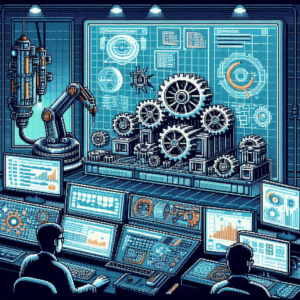Mechanical Systems Optimization Techniques Explained
Introduction to Mechanical System Optimization
Optimizing mechanical systems is essential for enhancing performance, efficiency, and reliability while reducing costs. This process plays a crucial role in various fields, including robotics and automotive engineering. Engineers rely on mathematical modeling and simulation to optimize mechanical designs. Various optimization techniques help achieve the best possible outcomes by refining system parameters.
Understanding Mechanical Systems
It consist of interconnected components designed to perform specific functions. They can be categorized as follows:
– Static Systems: Systems that remain unchanged over time, such as bridges and buildings.
– Dynamic Systems: Systems that evolve over time, such as vehicles and robots.
– Linear Systems: Systems with a direct relationship between input and output.
– Non-linear Systems: Systems where input-output relationships are non-linear and complex.
Optimizing these systems requires a deep understanding of system dynamics, kinematics, and external forces influencing their operation.
Mathematical Modeling for Mechanical System Optimization
Mathematical modeling is a cornerstone of mechanical system optimization. It involves creating equations to describe system behavior under different conditions. Key steps include:
– Defining the System: Identifying components and their interactions.
– Formulating Equations: Developing models that define motion, forces, and energy.
– Identifying Constraints: Considering limitations such as material properties and operational conditions.
Common mathematical techniques used in modeling mechanical systems include:
– Differential Equations: Describe dynamic system behavior over time.
– Linear Algebra: Solves systems of equations for engineering analysis.
– Optimization Algorithms: Includes methods like linear programming and genetic algorithms to determine optimal configurations.
Optimization Techniques for Mechanical Systems
Several optimization techniques can be applied to improve mechanical system efficiency. The most effective methods include:
1. Gradient-Based Methods
– Utilize the gradient of an objective function to reach an optimal solution.
– Efficient for smooth functions but struggles with highly non-linear systems.
2. Genetic Algorithms
– Inspired by natural selection, this method evolves solutions over multiple generations.
– Ideal for complex optimization problems with multiple local optima.
3. Simulated Annealing
– Mimics the annealing process in metallurgy to find global optima.
– Effective for solving large-scale optimization problems.
4. Particle Swarm Optimization
– Simulates social behaviors observed in nature (e.g., birds flocking).
– Particularly useful for multi-dimensional optimization problems.
5. Finite Element Analysis (FEA)
– A numerical method used to analyze system behavior under various conditions.
– Integrates well with optimization algorithms to improve design and efficiency.
Case Studies in Mechanical System Optimization
Case Study 1: Robotic Manipulators
Robotic manipulators are a prime example of mechanical systems that require optimization. The performance of these systems is influenced by design parameters, including joint configurations and actuator selection.
Optimization Goals:
Maximize payload capacity.
Minimize energy consumption.
Enhance speed and accuracy.
Optimization Techniques Used:
1. Kinematic Analysis: Determines optimal joint angles.
2. Dynamic Modeling: Assesses forces and torques for specific tasks.
3. Genetic Algorithms: Helps in selecting the most efficient designs.
Case Study 2: Automotive Suspension Systems
Automotive suspension systems must balance ride comfort and performance while ensuring safety.
Optimization Goals:
Minimize body roll during cornering.
Maximize ride comfort.
Ensure safety and stability.
Optimization Techniques Used:
1. Finite Element Analysis (FEA): Simulates suspension behavior under loads.
2. Multi-Objective Optimization: Finds a balance between comfort and handling.
Challenges in Mechanical System Optimization
Despite its advantages, optimizing mechanical systems presents several challenges:
1. Complexity of Systems: Many mechanical systems have highly intricate interactions.
2. Non-linearity: Non-linear behaviors complicate optimization algorithms.
3. Computational Resources: Many methods are computationally demanding.
4. Uncertainty: Variations in material properties and manufacturing require robust optimization strategies.
Future Trends in Mechanical System Optimization
The future of mechanical system optimization is evolving with new technological advancements. Key trends include:
Integration of Machine Learning: Machine learning algorithms can enhance optimization by learning from data and improving predictive accuracy.
Real-Time Optimization: The development of real-time optimization techniques will allow for dynamic adjustments based on changing conditions.
Sustainability Considerations: As environmental concerns grow, optimizing for sustainability will become increasingly important.
Advanced Materials: The use of advanced materials, such as composites and smart materials, will open new avenues for optimization.
Conclusion
Optimization of mechanical systems is vital for improving efficiency, performance, and reliability. By leveraging mathematical modeling and advanced optimization techniques, engineers can create highly optimized mechanical designs. The application of Optimization Methods for Mechanical System Dynamics continues to evolve, integrating AI, real-time processing, and sustainability-driven design choices.
At Cloudastra Technologies, we specialize in software solutions that enhance mechanical system optimization. Contact us today to discover how we can help you achieve better performance and efficiency in your projects.
Do you like to read more educational content? Read our blogs at Cloudastra Technologies or contact us for business enquiry at Cloudastra Contact Us.
